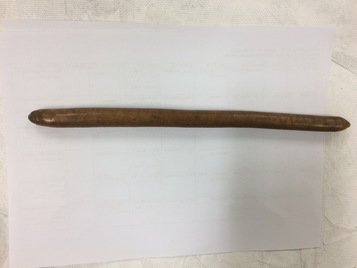EMB_VI_4696
Title: A message stick held in Ethnologisches Museum Berlin
Description: Original catalogue description: "Botschafts-Stab; ein Stamm (a) sucht die Waffenbruderschaft eines anderen (b) auf, um enen Dritten (c) gemeinschaftlich zu bekämpfen;"
Message: Botschafts-Stab; ein Stamm (a) sucht die Waffenbruderschaft eines anderen (b) auf, um einen Dritten (c) gemeinschaftlich zu bekämpfen; Translation: Message stick; a tribe (a) visits the brother-in-arms of another (b) in order to fight against third (c) collectively.
Date Created: 1882
Notes on date created: terminus ante quem
Item type: message stick in a collection
Subtype: traditional
State/Territory: WA
Notes on linguistic areas: Handwriting expert Anneke Hamann contacted by PK on 15 Oct 2018 to try to make sense of the location info: "xxx xxx W. Australien".
Source types: museum collection
Institution/Holder file: Ethnologisches Museum Berlin object identifier: VI 4646
Collector: Carl Ludwig Sahl
Media copyright: Ethnologisches Museum Berlin
Notes: Original filenames of images are likely to be wrong VI_4646 should be VI_4696 Anneke Haman did the annotations. She wrote: "I figured out that the small waves at the end of the lines in picture one (4696/97) are hyphens. So If I’m not mistaken most of the missing words are actually just endings. The only words missing in the account of the shipwreck are what I interpret as “Ausfahrt”, “Herfahrt” and something illegible with the German ß at the end. Therefore, it might be something old I don’t know.As to picture two (4700), the sentence does not really make sense, especially the verb “trägt” but I’m almost certain my interpretation of the handwriting is correct in this case. Maybe the author himself left out a word." Piers marked up location info (".... W. Australien) and material in far right column for review by Anneke H. She wrote in reply: "What I can say for certain is that the horizontal red circle to the right contains “cm lang Australien”. Which of course doesn’t make any sense. The “cm lang” is part of the description of the message stick (29,5cm long). The “Australien” may be the extension of the column to the right (vertical circle). Concerning the right circle I’d say the first word starts with a capital G and I would bet it continues over the next line because the next word starts with what looks like an h or f. There are not many German words this length starting with an h or f. It does look like “Gef-hart…horn” but that’s not even a word. I’ts very likely the passage end with “Carl Sahl in Sidney” but to be honest, without your hint I wouldn’t have read “Carl” because the ending is that blurry. What’s really interesting is the modern, not Sütterlin e in Sidney. I can’t really make sense of the writing in the horizontal circle to the left containing W. Australia but noticed some oddities there as well. The hand writing looks different from the rest. First of all it’s written in pencil instead of ink. And the capital A looks different and a lot newer. It’s possible this was written later and by a different person. The numbers following the “W. Australien” look like this person referenced a different section or message stick. If you have the corresponding files “2582 u[nd] 2233/36” they might give you a hint on what the author tried to reference. And he had a terrible handwriting, that’s for sure." Piers replied: "Thanks Anneke, This is really useful. I had incorrectly guessed that "cm lang" was "sammlung"! The crossreferences to other artefacts aren't usually helpful. Often they are preceded by "dgl." which stands for dergleichen and the comparison is usually on the basis of visual similarities rather than origins. My bad guess for the words preceding W.Australien was something like "dorf__ W. Australien". There are very few settlements in the north west of Western Australia, where I suspect the artefact comes from, but the word doesn't like any village I know from that area. (In fact, I lived in that region for three years.) Thanks again for taking the time with this, Piers" Anneke replied: "“Dorf” could be possible but the first letter is a little too small to pass for a capital D. Plus, the capital W and A are not written in Sütterlin style. Therefore it seems likely the author would have written a modern D as well. Yet again, this is just a wild guess. Said letter could also be “v” followed by “o” and… something “h”-ish. Maybe “f” but “h” seems more likely because the lower… how do you call that? Anyway, the lower part of the letter is not strait but bent. In writing that I just realized the next word is most certainly “sicher”. What I first thought was “u” looks more like “i” followed by “c”. That would make “…h sicher W[est] Australien”. Does that make any sense? And a minor addition to the part on the right (it seems I’m having way too much fun deciphering this): if the first two lines are still written in Sütterlin, the first word on the second line could be “herrn”. That would make “Ge…- herrn Carl Sahl in Sidney”. Again, all the letters in Sahl and Sidney look much more modern than the rest, so the two words in the beginning could contain a mixture of old and new letters. Anyway, I doubt that whatever is written there contains a specific location. I hope that helps. If you come across another illegible passage, feel free to ask me! Anneke"
Media Files:
Data Entry: Piers Kelly







